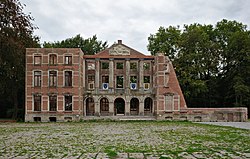
Lede is a municipality in the Belgian province of East Flanders, in the Denderstreek near the cities of Ghent, Aalst and Dendermonde.
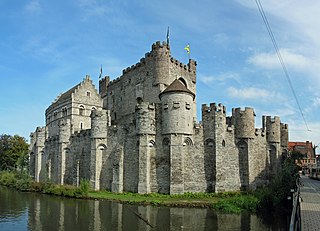
The Gravensteen is a medieval castle at Ghent, East Flanders in Belgium. The current castle dates from 1180 and was the residence of the Counts of Flanders until 1353. It was subsequently re-purposed as a court, prison, mint, and even as a cotton factory. It was restored over 1893–1903 and is now a museum and a major landmark in the city.
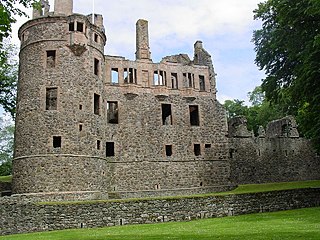
Huntly Castle is a ruined castle north of Huntly in Aberdeenshire, Scotland, where the rivers Deveron and Bogie meet. It was the ancestral home of the chief of Clan Gordon, Earl of Huntly. There have been four castles built on the site that have been referred to as Huntly Castle, Strathbogie Castle or Peel of Strathbogie.

Jean-Nicolas Servan, also known as Giovanni Niccolò Servandoni was an Italian decorator, architect, scene-painter, firework designer and trompe-l'œil specialist.

Casale Monferrato is a town in the Piedmont region of Italy, in the province of Alessandria. It is situated about 60 km (37 mi) east of Turin on the right bank of the Po, where the river runs at the foot of the Montferrat hills. Beyond the river lies the vast plain of the Po valley.

Jean-François-Thérèse Chalgrin was a French architect, best known for his design for the Arc de Triomphe, Paris.

San Giovanni in Conca is a crypt of a former basilica church in Milan, northern Italy. It is now located in the centre of Piazza Missori.
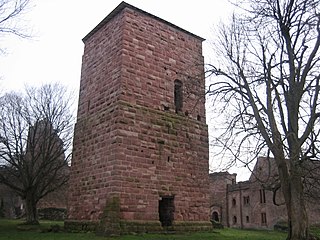
The château du Lutzelbourg is a château founded by Pierre de Lutzelbourg in the 11th century on a rocky promontory overlooking the Zorn valley in France at an altitude of 322m, in Lutzelbourg (Moselle). It has been classified as a Historic Monument since February 1930 in France

The Marquess of Lede was a Flemish title in use during the Ancien Régime. Lede is a city in Flanders, Belgium.

D'Ursel Castle used to be the private summer residence of the Duke of Ursel in Hingene in the municipality of Bornem, province of Antwerp, Belgium. Today it is property of the State, and opened to the public.
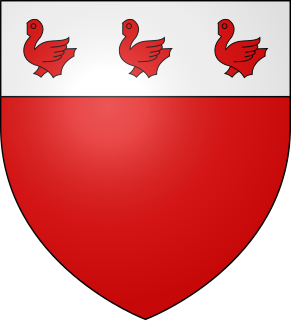
The House of Ursel is the name of an important old Belgian noble family of German origin. The Head of the House is styled the Duke of Ursel, while other members are styled as Count/Countess d'Ursel.

Pierre-Antoine Demachy was a French artist who specialized in painting ruins, Trompe-l'œil architectural decorations and imaginative scenes of Paris.

The Marquess of Wemmel was a Flemish title in use during the Ancien Régime, Wemmel is a city in Flanders.
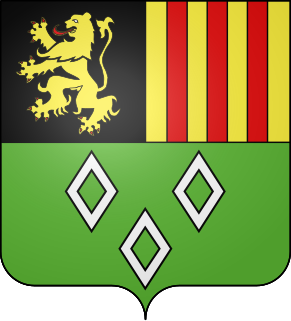
The House of Glymes was a noble house of Belgium, of descendants of a bastard branch of the Dukes of Brabant. Glymes or Glimes is a municipality of Incourt. Their descendants of the branch of Grimberghen are styled as the Prince de Grimberghen.
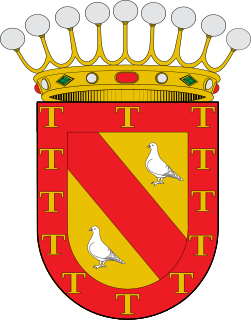
Coloma or de Coloma or Colomba is an old important Spanish Noble House. A branch belongs to the Flemish nobility, and became the Counts of Bornhem. Other branches became the Counts of Elda, Marquesses of Espinar, Marquesses of Noguera and Marquesses of Canales de Chozas.

Charles Elisabeth Conrard, 2nd Duke d'Ursel and of Hoboken, Prince of Arches and Charleville and Count of Grobbendoncq (1717–1775) was a Belgian Duke. He succeeded his father and became the second Duke of Ursel in 1738.

The Castle of the Pico is a castle in the city center of Mirandola, in the province of Modena, Italy.

Borgo Nuovo, originally known as via Alessandrina, also named via Recta or via Pontificum, was a road in the city of Rome, Italy, important for historical and architectural reasons. Built by Pope Alexander VI Borgia for the holy year of 1500, the road became one of the main centers of the high Renaissance in Rome. Borgo Nuovo was demolished together with the surrounding quarter in 1936–37 due to the construction of Via della Conciliazione.

Prinsenkasteel was a castle located in Grimbergen, Belgium. It was the residence of the lords of Grimbergen from the 14th Century onwards. The castle ruins are located in Prinsenbos Park.

Bueren Castle is a 16th-century moated castle in Melle-Kwatrecht. The castle domain is 10 hectares and is located in two municipalities.
